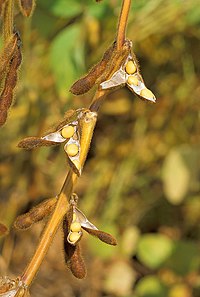
Photo from wikipedia
Nematodes cause great damage to soybean crops in Paraguay. Studies have investigated correlations between phytonematodes and soil chemical and physical properties, but little is known about correlations with the nutritional… Click to show full abstract
Nematodes cause great damage to soybean crops in Paraguay. Studies have investigated correlations between phytonematodes and soil chemical and physical properties, but little is known about correlations with the nutritional status of soybean crops. This study aimed to assess correlations between Pratylenchus, Meloidogyne, soil chemical properties, soil texture, and the nutritional status of soybean. The experiment was carried out in Paraguay in areas of commercial soybean cultivation infested with nematodes, totaling 83 collection sites. Analyses of nematodes in soil and root samples, chemical characterization of soil acidity, fertility, and texture, and chemical characterization of soybean leaves were performed, totaling 36 variables. Data were subjected to principal component analysis. Soil Al3+ favored the development of Pratylenchus populations. Organic carbon negatively influenced Meloidogyne. K+ and Mg2+ negatively affected Pratylenchus and Meloidogyne, respectively. Pratylenchus and Meloidogyne correlated negatively with clay contents. In sandy soils, there was a negative correlation between Pratylenchus and sand content. Pratylenchus and Meloidogyne led to an increase in foliar Ca and a decrease in foliar P. Soil fertility management can be used as part of the integrated management of Pratylenchus and Meloidogyne. It is worth mentioning that, in field studies, the complexity of biotic and abiotic factors in the crop system may contribute to diverging results, making it difficult to establish a single response pattern, especially when some factors affect others.
Journal Title: Journal of Agricultural Science
Year Published: 2023
Link to full text (if available)
Share on Social Media: Sign Up to like & get
recommendations!